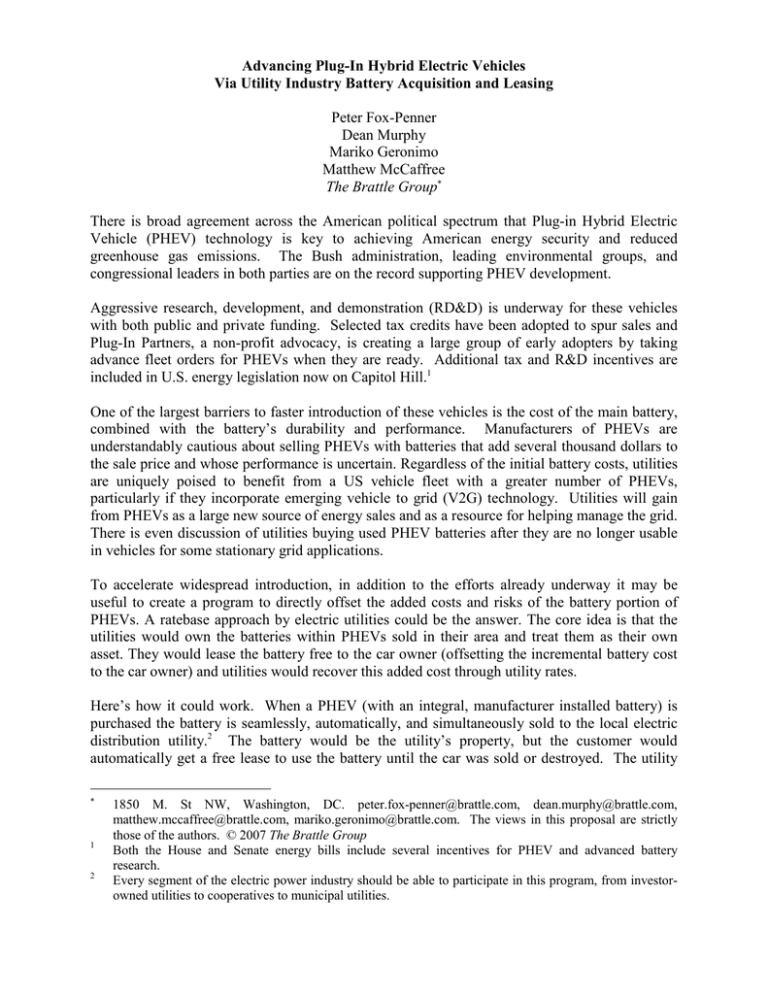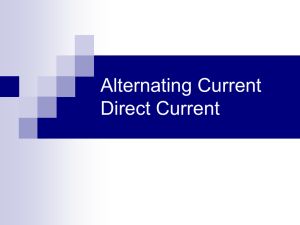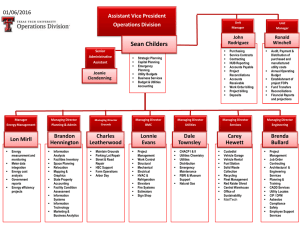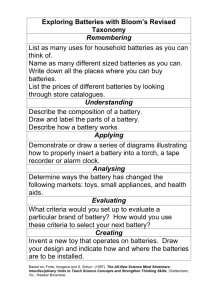Advancing Plug-In Hybrid Electric Vehicles Peter Fox-Penner
advertisement

Advancing Plug-In Hybrid Electric Vehicles Via Utility Industry Battery Acquisition and Leasing Peter Fox-Penner Dean Murphy Mariko Geronimo Matthew McCaffree The Brattle Group∗ There is broad agreement across the American political spectrum that Plug-in Hybrid Electric Vehicle (PHEV) technology is key to achieving American energy security and reduced greenhouse gas emissions. The Bush administration, leading environmental groups, and congressional leaders in both parties are on the record supporting PHEV development. Aggressive research, development, and demonstration (RD&D) is underway for these vehicles with both public and private funding. Selected tax credits have been adopted to spur sales and Plug-In Partners, a non-profit advocacy, is creating a large group of early adopters by taking advance fleet orders for PHEVs when they are ready. Additional tax and R&D incentives are included in U.S. energy legislation now on Capitol Hill.1 One of the largest barriers to faster introduction of these vehicles is the cost of the main battery, combined with the battery’s durability and performance. Manufacturers of PHEVs are understandably cautious about selling PHEVs with batteries that add several thousand dollars to the sale price and whose performance is uncertain. Regardless of the initial battery costs, utilities are uniquely poised to benefit from a US vehicle fleet with a greater number of PHEVs, particularly if they incorporate emerging vehicle to grid (V2G) technology. Utilities will gain from PHEVs as a large new source of energy sales and as a resource for helping manage the grid. There is even discussion of utilities buying used PHEV batteries after they are no longer usable in vehicles for some stationary grid applications. To accelerate widespread introduction, in addition to the efforts already underway it may be useful to create a program to directly offset the added costs and risks of the battery portion of PHEVs. A ratebase approach by electric utilities could be the answer. The core idea is that the utilities would own the batteries within PHEVs sold in their area and treat them as their own asset. They would lease the battery free to the car owner (offsetting the incremental battery cost to the car owner) and utilities would recover this added cost through utility rates. Here’s how it could work. When a PHEV (with an integral, manufacturer installed battery) is purchased the battery is seamlessly, automatically, and simultaneously sold to the local electric distribution utility.2 The battery would be the utility’s property, but the customer would automatically get a free lease to use the battery until the car was sold or destroyed. The utility ∗ 1 2 1850 M. St NW, Washington, DC. peter.fox-penner@brattle.com, dean.murphy@brattle.com, matthew.mccaffree@brattle.com, mariko.geronimo@brattle.com. The views in this proposal are strictly those of the authors. © 2007 The Brattle Group Both the House and Senate energy bills include several incentives for PHEV and advanced battery research. Every segment of the electric power industry should be able to participate in this program, from investorowned utilities to cooperatives to municipal utilities. would amortize the battery investment through a small surcharge on distribution rates. When the car was sold the battery lease would transfer to the new owner. Cars that were retired would require the manufacturer to retire or recycle the battery just as today. The program would be needed only for the first five years or so of PHEV sales, perhaps linked explicitly to the number of vehicles sold (say, the first half million PHEVs). After this, production volume and manufacturing cost savings should reduce costs to the point where much less support was needed. The cost of the batteries would be recovered by utilities through electricity rates. This program would be in effect while PHEV sales are in their infancy – in the thousands or hundreds of thousands each year – and discontinue once sales reach full commercial scale. If each battery costs about $3,600 and lasts for 12 years, the annual carrying cost for the utility would be about $475 per battery. If PHEV sales were to follow the trajectory of hybrid electric vehicle sales there would be a 0.05% fleet penetration of about 130,000 vehicles (or just over 0.1% of households with PHEVs), within the first six years of sales. At this point battery cost recovery would increase the average residential customer bill by just 4¢ per month, or 49¢ per year. By the time PHEVs reach a half million in cumulative sales (about 0.2% of the light-duty vehicle fleet), the goal of accelerating PHEV battery technology to commercial production levels would be achieved. The first-cost barrier to introducing PHEVs to consumers would be reduced immensely, and PHEVs could compete on a level playing field with alternative vehicle technologies. At this level, where the subsidies are largest, the impact on the average residential electricity bill would be only 15¢ per month, or about $1.80 per year. A lease arrangement with the utilities would leave the choice of battery, warranty, and other terms undisturbed. Car and battery manufacturers will come to their own commercial terms regarding performance guarantees, warranties, and so on. The car owner would be entitled to the same protection as if they owned the battery and utilities would be in the business of providing electricity, not guaranteeing car parts. An alternative way to administer the program would be to create a nationwide non-profit publicprivate corporation that owned the batteries and centralized program administration. Utilities would contribute capital to this corporation, allowing them to own shares in it. These investments would be put into the rate base for all utilities allowing them to recoup their investment through rates (with a reasonable return on investment, as for other capital assets). Plug-in hybrids are a crucial solution to rising emissions and oil over-dependence. Battery costs are the main barrier to broad-scale PHEV deployment. Every possible acceleration strategy should be put to work, but utilities alone have the customers, synergies, and balance sheets to help get these cars on the road as soon as possible. This is admittedly an unusual, “out-of-the-box” idea. To help explain the idea and respond to some of the more obvious questions that are certain to arise, we have provided a basic Q-and-A discussion. Q. What are the advantages of utilities owning the battery? A. Ultimately, the batteries are going to be a part of the nation’s electric power grid anyway. Utilities have a low cost of capital and an ability to amortize the incremental first costs over a large sales base. In addition, it is the electric utilities whose sales will benefit from PHEV growth. Q. Won’t it be undesirable for utilities to have assets that move around between areas and states, so their assets may not even be used by their own customers and grids? A. This proposal should be implemented nationally and tied to the location where the car is garaged for insurance purposes. If the car changes its location, the asset should shift to the new local distribution utility’s rate base. A national public-private corporation should be able to administer this with a single central database? Q. What regulatory approvals are required for utilities to create this? A. Utilities would definitely want – and should receive – legislative assurances that they can amortize these costs. Such assurances have been provided to utilities for other purposes in the past. Q. Why doesn’t the federal government simply create a fund to buy down the battery itself, or give grants or tax credits to buyers or automakers? A. All these approaches are reasonable if implemented wisely. However, they typically require significant taxpayer funding or the first-cost barrier remains large. Many citizens frown on direct federal subsidies to retail purchases. Utilities have the means to raise the capital for this purchase and they have a well-tested framework for recouping their investment. If the federal government cannot afford to remove the first-cost barrier utilities are the next logical choice. Q. Isn’t owning and managing batteries beyond the core capabilities of most utilities, requiring them to take on a new set of administrative responsibilities? A. There are a variety of ways the industry could pool and greatly reduce the administrative burdens. A dedicated public-private acquisition and leasing corporation could be created that acquires the batteries and administers the program for all utilities; utilities would invest in this corporation rather than the batteries themselves. Q. Wouldn’t all utilities have to participate in this in order to allow customers to take advantage of it anywhere? A. Yes. If utility participation wasn’t universal this automatic battery buy-down/lease could only be offered to cars in certain areas. If federal policy makers wanted to make the program universal, it would be easy to legislate a federal surcharge on power distribution rates and fund the public-private leasing corporation in this manner. Under this approach, there is no ratebasing of the batteries and local utilities are simply collection agents. Q. PHEV batteries are still undergoing development. Would this program allow for continued innovation in battery technology? A. Yes. The relationship between the car and battery manufacturers would be independent of this program. Car manufacturers would still have the same incentive to incorporate the most innovative, cost effective technology in their cars. Copyright © 2007 The Brattle Group, Inc.



